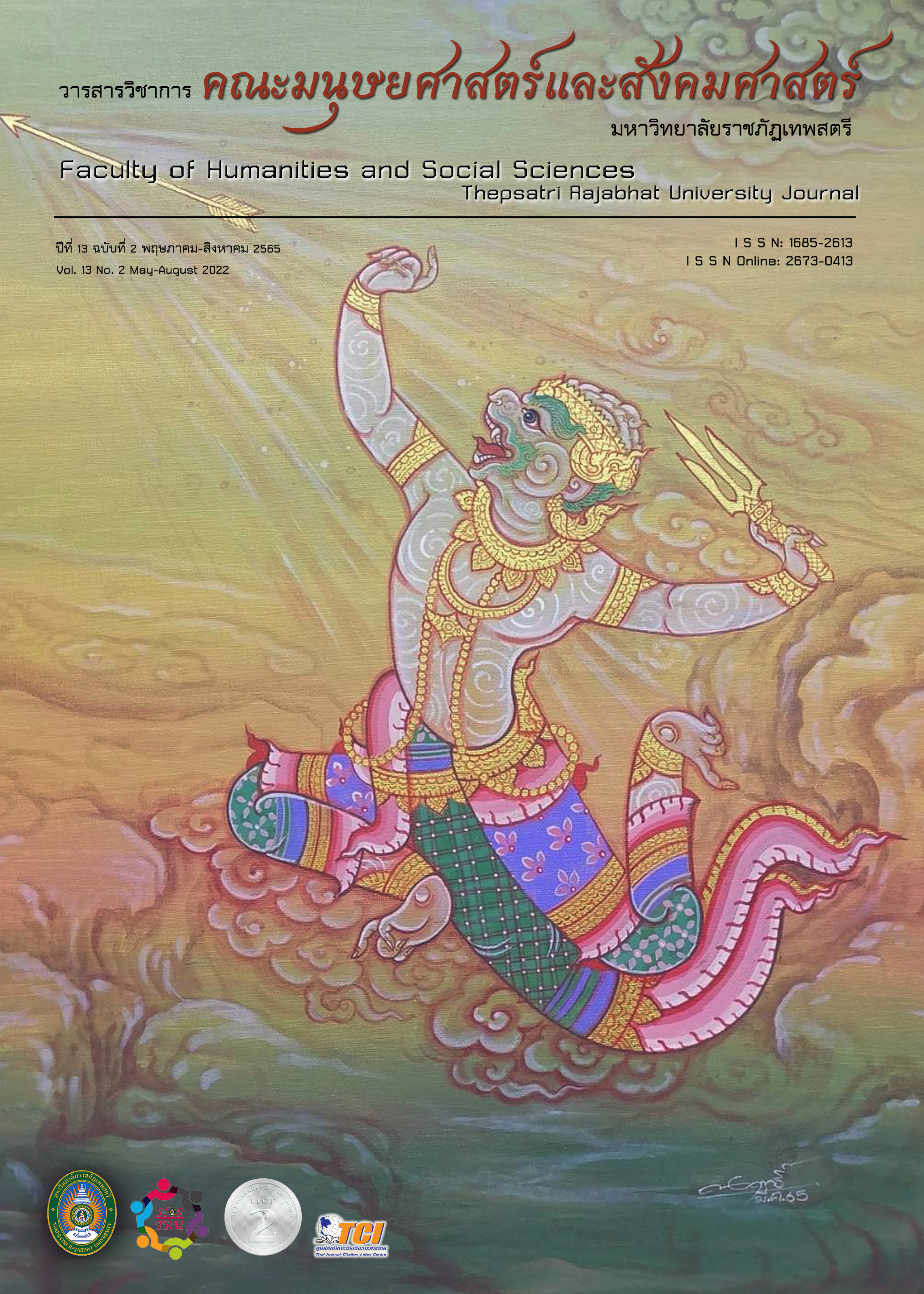Factor Analysis of E-learning Readiness of Undergraduate Students in Faculty of Education Ramkhamhaeng University
Main Article Content
Abstract
The purpose of this research was to analyze factors of E-learning readiness of students in Faculty of Education Ramkhamhaeng University. The sample was 1,067 undergraduate students. The research instrument was E-learning readiness instrument with the Index of Item-Objective Congruence being 1.00 and the reliability of the whole questionnaire being 0.814. The analysis of E-learning readiness components used exploratory factor analysis (EFA) with the method of principal component analysis and direct oblimin.
The research findings were as follows: The E-learning readiness components of the students in Faculty of Education Ramkhamhaeng University had six components. The components consisted of 1. self-efficacy, 2. access of opportunity, 3. adjustment, 4. concentration, 5. sense of comfort, and 6. self-management. All of these 6 components could be explanatory of variance at 53.671 percent.
Downloads
Article Details

This work is licensed under a Creative Commons Attribution-NonCommercial-NoDerivatives 4.0 International License.
The content and information presented in articles published in the Academic Journal of the Faculty of Humanities and Social Sciences, Thepsatri Rajabhat University, are solely the opinions and responsibilities of the respective authors. The editorial board of the journal neither necessarily agrees with nor assumes any responsibility for such content in any manner whatsoever.
All articles, information, content, and images published in the Academic Journal of the Faculty of Humanities and Social Sciences, Thepsatri Rajabhat University, are the copyright of the journal. Any person or organization wishing to reproduce, disseminate, or otherwise utilize all or any part thereof must obtain prior permission from the Academic Journal of the Faculty of Humanities and Social Sciences, Thepsatri Rajabhat University.
References
ชโรชีนีย์ ชัยมินทร์. (2562, มกราคม - มิถุนายน). MOOC: เพื่อการเรียนรู้ตลอดชีวิตในศตวรรษที่ 21. วารสารมนุษยศาสตร์และสังคมศาสตร์ มหาวิทยาลัยราชภัฏเชียงใหม่, 1(1), 46-70.
ชนินทร์ ตั้งพานทอง. (2560). ปัจจัยที่มีต่อผลสัมฤทธิ์ทางการเรียนออนไลน์เพื่อเสริมการเรียนการสอน. วิทยานิพนธ์ปริญญามหาบัณฑิต จุฬาลงกรณ์มหาวิทยาลัย.
ณฐภัทร ติณเวส, และฐาปนีย์ ธรรมเมธา. (2559, กันยายน – ธันวาคม). การศึกษารูปแบบการจัดการศึกษาออนไลน์ระบบเปิดแบบ MOOC ของอุดมศึกษาไทย. Veridian E-Journal, Silpakorn University ฉบับภาษาไทย สาขามนุษยศาสตร์ สังคมศาสตร์ และศิลปะ, 9(3), 1463-1479.
ณัฏฐภรณ์ หลาวทอง. (2561). การสร้างเครื่องมือการวิจัยทางการศึกษา (พิมพ์ครั้งที่ 2). กรุงเทพฯ: โรงพิมพ์แห่งจุฬาลงกรณ์มหาวิทยาลัย.
สำนักงานทางวิชาการและทดสอบประเมินผล. (2563). สถิติเกี่ยวกับนักศึกษาระดับปริญญาตรี. สืบค้น มีนาคม 27, 2564, จาก http://www.regis.ru.ac.th/index.php/10-2013-12-20-06-46-50/20-stat.
Alem, F., Plaisent, M., Zuccaro, C., & Bernard, P. (2016, December). Measuring e-Learning readiness concept: Scale development and validation using structural equation modeling. International Journal of e-Education, e-Business, e-Management and e-Learning, 6(4), 193-207.
Asaari, M. H. A. H., & Karia, N. (2005). Adult learners and e-learning readiness: A case Study. Paper presented at Proceedings of European College Teaching & Learning Conference 2005, June 13 – 15, page 1 - 5.
Atkinson, J. K., Blankenship, R., & Droege, S. (2011). College student online learning Readiness: A comparison of students in the U.S.A., Australia and China. International Journal of Global Management Studies Professional, 3(1), 62–75.
Clark, R. C., & Mayer, R. E. (2016). E-Learning and the science of instruction: Proven Guidelines for Consumers and Designers of Multimedia Learning (4th edition). Hoboken, New Jersey: Wiley.
Choucri, N., Maugis, V., Madnick, S., & Siegel, M. (2003). Global e-readiness - for what?. Retrieved January 23, 2021, from https://www.researchgate.net/publication/228940912_Global_e-Readiness-For_What.
Chowdhury, M. S., & Shahabuddin, A. M. (2007, Winter). Self-Efficacy, Motivation and Their Relationship to Academic Performance of Bangladesh College Students. College Quarterly, 10(1), 1-9.
Demir, Ö., & Yurdugül, H. (2015, February). The Exploration of models regarding e-learning readiness: Reference Model Suggestions. International Journal of Progressive Education, 11(1), 173–194.
Doe, R., Castillo, M. S., & Musyoka, M. M. (2017, Spring). Assessing online readiness of students. Journal of Distance Learning Administration, 20(1), 1–13.
Dray, Barbara J., Lowenthal, Patrick R., Miszkiewicz, Melissa J., Ruiz‐Primo, Maria, Araceli, & Marczynski, Kelly. (2011). Developing an Instrument to Assess Student Readiness for Online Learning: A Validation Study. Distance Education, 32(1), 29–47.
Hair, J. F., & Anderson. (1995). Multivariate Data Analysis. New Jersey: Prentic-Hall Inc.
Hair, J. F., Black, W. C., Babin, B. J., & Anderson, R. E. (2010). Multivariate Data Analysis: A Global Perspective. New Jersey America: Pearson.
Hung, M. L., Chou, C., Chen, C. H., & Own, Z. Y. (2010, November). Learner Readiness for Online Learning: Scale Development and Student Perceptions. Computers & Education, 55(3), 1080–1090.
Kaur, K., & Abas, Z. W. (2004, November - December). An assessment of e-learning readiness at the Open University Malaysia. Paper Presented at the International Conference on Computers in Education (ICCE2004). Melbourne: Australia.
Pearson, R. H., & Mundform, D. J. (2010, November). Recommended sample Size for Conducting Exploratory Factor Analysis on Dichotomous Data. Journal of Modern Applied Statistical Methods, 9(2), 358-368.
Pett, M. A., Lackey, N. R., & Sullivan, J. J. (2003). Making Sense of Factor Analysis: The Use of Factor Analysis for Instrument Development in Health Care Research. California: Sage.
Smith, P. J. (2005). Learning Preferences and Readiness for Online Learning. Educational Psychology, 25(1), 3–12.
Smith, P. J., Murphy, K. L., & Mahoney, S. E. (2003). Towards Identifying Factors Underlying Readiness for Online Learning: An Exploratory Study. Distance Education, 24(1), 57-67.
Tabot, Oyibo, & Hamada (2013). E-learning Evolution: Past, Present and Future. Retrieved January 20, 2021, from https://www.researchgate.net/publication/287911238_E-learning_evolution_Past_present_and_future.
Taherdoost, H., Sahibuddin, S., & Jalaliyoon, N. (2014). Exploratory Factor Analysis; Concepts and Theory. Advances in Applied and Pure Mathematics, 27, 375-382.
Tsai, M. J. (2009, January). The Model of Strategic e-Learning: Understanding and Evaluating Student e-learning from Metacognitive Perspectives. Educational Technology & Society, 12(1), 34–48.
Watkins, R., Leigh, D., & Triner, D. (2004, December). Assessing Readiness for e-learning. Performance Improvement Quarterly, 17(4), 66-79.
Yadollahi, S., Izadparast, M., & Rahimi, M. (2013). An Assessment of the e-Learning Readiness Among EFL University Students and its Relationship with Their English Proficiency. Paper presented at the 4th International Conference on e-Learning and e-Teaching, ICELET 2013, February 13 – 14.
Yu, T., & Richardson, J. C. (2015, December). An Exploratory Factor Analysis and Reliability Analysis of The Student Online Learning Readiness (SOLR) Instrument. Online Learning, 19(5), 120–141.
Zhu, M., & Doo, M. Y. (2021). The Relationship Among Motivation, Self-monitoring, Self-management, and Learning Strategies of MOOC Learners. Journal of Computing in Higher Education, 34(2), 321-342.


